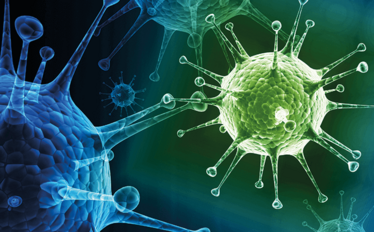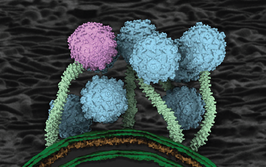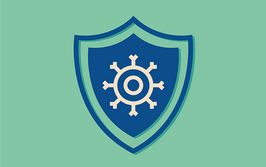
The Winning Formula
Meet the three frontrunners of The Medicine Maker 2017 Innovation Awards – spanning influenza vaccine development, a virtual reality space, and a way to boost monoclonal antibody manufacturing. Is there a recipe for success?
In December 2017, we celebrated the 15 most exciting drug development and manufacturing technologies in The Medicine Maker’s annual Innovation Awards. But which were truly the most groundbreaking? We asked you, our readers, to decide – and we received an overwhelming response.
Here, we introduce you to some of the personalities behind your top three picks – and follow their journey from initial inspiration to commercial innovation. SGS claimed the top spot with their H3N2 challenge virus, closely followed by OUAT!’s HakoBio platform and GE Healthcare’s MabSelect PrismA in second and third place, respectively. Without further ado, let’s meet the grand winners…
#1 Agents of Innovation
We must find ways to better help vaccine manufacturers to fight the flu – and this is why we developed a new challenge agent for H3N2.
Influenza has been an enemy of humanity for over a thousand years and its power is often underestimated. It is not unusual for people with a bad cold to claim to have the flu, forgetting how utterly debilitating – and possibly fatal – the infection can be. Most readers will have experienced the flu and know that it is a miserable experience. For some, it can cause extreme inflammation, promoting cytokine release, and causing an immune cascade that can prove fatal. Much like the common cold, influenza represents a moving target, making vaccines and treatments difficult to develop. Challenge agents, used to induce a physiological response to test vaccines and treatments, can be an invaluable tool to help vaccine manufacturers keep up with this ever-changing virus – and, therefore, better protect patients. Here’s the story of how my team at SGS developed a challenge agent for H3N2.
We are losing the war
Fighting the flu is difficult because of the virus’s ability to change its antigenicity, which affects how susceptible different populations will be to it. Antigenic drift – when a new milder or more virulent strain emerges – can occur, for example. Or there might be an antigenic shift, meaning that the virus re-assorts with another strain, such as avian or pig, to form an entirely new strain that nobody has come into contact with before.
One of the most predominant strains circulating in humans now is H3N2, which has caused very high death rates in the elderly, akin to those seen in the 2009 pandemic with H1N1. Some of the changes in the new strains are challenging because current vaccines are not well aligned. Even small changes in the virus genome can allow the disease to “escape” current vaccines, causing efficacy to drop. For example, between 2005 and 2015, the vaccine efficacy for H3N2 – which is drifting – has dropped to just 23 percent, which is terrible. For H1N1, which hasn’t changed a great deal since 2009, vaccine efficacy is around 61 percent. We must also consider future strains – re-assortments could bring in novel avian strains, such as H5, H7 and H9, which would be entirely new to human populations, potentially causing havoc if we do not control them quickly.
The company:
SGS provides clinical research and bioanalytical testing with a specific focus on early stage development and biometrics. The company has its own clinical pharmacology unit in Belgium, including a human challenge testing facility, and two phase I patient units based in Belgium and Hungary.
The innovation:
H3N2 Challenge Virus is a community-sourced influenza virus manufactured to cGMP, with lineage that stems from the seasonally epidemic, non-haemagglutinating H3N2 viruses that arose in the 2010/2011 influenza season, and that have come to predominate since 2014/2015. The H3N2 Challenge Virus represents one of the most common, current circulating strains of influenza of a pandemic origin and can be used for testing the H3N2 portion of prospective prophylactic and therapeutic vaccines.
Some of today’s vaccines only offer a very short window of protection – as little as 3–6 months. If vaccination is performed too early in the season, it’s possible for patients to become susceptible before it ends. We need more robust vaccines that stimulate long-term responses and longer periods of protection – and we need to be able to do it quickly.
For traditional vaccine development, you need a preclinical phase, first-in-human studies, and field studies, which takes time – around 10 years. By then, the virus you are targeting will often have shifted. This problem was realized early on with seasonal vaccines, so there is now an accelerated process in place. The safety work has already been done – all that changes is the antigens or virus strains within the vaccine, and a new vaccine can be developed in around six to eight months. For entirely novel vaccines, the process is much longer – involving preclinical, clinical, and late phase trials. We need to develop new vaccines quickly enough to keep up with changes in virus antigenicity and structure, while still having a safe and regulated manufacturing process. When seeking approval for a vaccine, manufacturers require proof of real-world effectiveness. This can be achieved in studies in the community, but these trials are expensive and the low rates of infection can lead to the need for a large patient pool. A challenge agent offers a more focused study, with early data of how a vaccine may work in the real world.
An ancient challenge
Challenge is not a novel concept for vaccination. If we go back to very early attempts to inoculate people against variola virus (smallpox), cowpox was used to produce a cross-reactive antibody. Challenging people with a live virus to induce protective responses or to study disease mechanisms is a tactic that has been around for hundreds of years. If we fast forward to the last century, more structure was introduced, with informed consent and strict manufacturing and clinical trial procedures being developed. As one impressive example, the Common Cold Unit set up in the UK in 1946 challenged people with live rhinovirus to study various cold remedies – and subsequently eliminated many old wives tale remedies (including gems such as wrapping your feet in cooking foil or placing an onion in your pocket!). To this day, the challenge agent has remained a useful tool for selecting effective vaccines and drugs, and for making timely go or no-go decisions on drug and vaccine candidates.
Despite its long history, challenge trials are still seen as somewhat novel in clinical drug and vaccine development – but I think that this perception is increasingly being challenged (if you’ll excuse the pun) by the scientific community. The practice has been accepted since Edward Jenner’s seminal work in the 18th century and, with all the regulation and oversight we have today, the public should be reassured that it is neither possible nor ultimately advantageous to create a challenge agent that could be potentially detrimental and dangerous to subjects. Such agents are developed in strict accordance with regulatory guidelines (GMP) and are also subject to a comprehensive testing program in animals and humans prior to use in commercial or academic settings.
Regulatory agency governed challenge trials can represent an effective, accelerated model for candidate selection that obtains early efficacy data, thus allowing pipelines to accelerate. For example, the cholera vaccine VaxChora is an oft cited example where measures of efficacy were predicated on challenge data (300 subjects versus a normal study of 60-120 subjects). As challenge trials have become more regulated and refined – and the challenge agents better represent wild type disease – we continue to improve our emulation of field trials, and that also allows us to give some prognostic and predictive values that can translate into everyday populations.
Developing H3N2
I’ve been working in the pharma industry since the 1980s and I know how important good models of disease are in helping to identify new targets for intervention. In particular, I have always been fascinated by the development of vaccines and how we can create more robust disease protection. After learning about challenge agents and seeing the exciting data that contributed to development programs, I wanted to get involved.
When I first moved to SGS as a project director for their infectious diseases division, I realized that one of the greatest threats to global health was the emergence of profound antigenic changes in the circulating H3N2 flu viruses – there was a new strain emerging around the time I came to SGS and in my second year with the company many of our own staff became infected. The emergence of this novel strain of H3N2 was a serendipitous opportunity, as it was one of the newly emergent, non-hemagglutinating strains. We isolated the new strain from a pediatric patient (the son of a staff member!) – a great success in itself as this proved to be a very “clean” example of the infection, without concomitant disease or sequelae (later, adverse events) at follow-up.
H3N2 strains were evading some flu surveillance methods at that time, such as hemagglutination inhibition testing, for the very reason that they were non-hemagglutinating. They just weren’t showing up on the radar and vaccine programs were overlooking them, leading to sub-optimal protection programs. It was rewarding to have the opportunity to develop a new challenge agent to help such programs protect communities by testing against the new “bad boy” in the playground. My plan was to make a stronger, hotter virus that was as close to wild type as possible to emulate what was going on in the field. Many challenge agents are attenuated or weaker than those you see in the real world, and this isn’t perfect because it can lead to false readings of efficacy and provide less information on how the candidate will actually perform when it leaves the clinical trial unit.

The development of a challenge agent is not a well-trodden path. Every time one is manufactured, it’s a case-by-case scenario from a regulatory point of view. In some ways, you don’t require the same level of proof of safety as you would for a vaccine, which may be used in all age ranges and immunity levels within a community, in very large numbers. With a challenge agent, you are using a controlled, screened population. On average, it takes two to three years to develop a new challenge agent, but I firmly believe it is beholden upon the industry to find more rapid, and safe but effective, methods of manufacturing if we’re going to keep up with the changes in circulating viruses. I don’t believe it is the way forward to continue to use older, non-drifted viruses in challenge studies – the more you can stay relevant to predominant circulating viruses, the more likely you are to see your results repeated in the field.
To create a challenge agent, you need original virus, isolated from a “case” patient and you must run tests on that individual to ensure they aren’t suffering from other diseases that may cloud the issue of disease progression and outcomes. You must continue testing your virus throughout development to ensure you’re not introducing anything unintended, such as other viruses or bacteria. The final product is tested using deep sequencing to identify any signs of potential contamination. Then you move on to animal testing to see if the agent causes a typical disease and sheds enough virus to make measuring the course of infection viable. The aim is to produce an extremely pure, refined virus with a typical disease profile.
For the SGS influenza agent, A/Belgium/4217/2015 [H3N2], we performed the manufacturing (in eggs), jumped through all the hoops and hurdles, such as adventitious testing with long incubation periods to exclude slow growing contaminants, and also found a good neutralizing antibody to enable us to block the H3N2 before seeding not cell lines – this work was all to show that the only infectious agent present in the challenge stock was a pure suspension of A/Belgium H3N2. With the help of our partners and of regulators, we managed to go from a community isolate through to release of a licensed agent, including first-in-human testing, in 12–18 months, which I consider quite an achievement.
But whenever you try to create something new, there will always be setbacks – I found there were more things to consider than I could ever have dreamt of when I first began the project. For example, we only did one round of amplification in chicken eggs, but we had three different egg suppliers as we were struggling to grow the virus to a high enough level or titer. Every day had its own hurdle and we had to find ways to try and accelerate the process. I could never have juggled everything without my project manager – it’s simply not possible for one person to find the time to do the science, business development and coordinate manufacture!
We’ve learned a lot from the project about developing challenge agents; and though I wouldn’t say it gets easier each time, there are certainly fewer surprises!

Creating the next generation
Producing a virus that exactly matched the original genomic sequences of the source or seed virus from the case patient was a very proud moment. We also saw 100 percent infection rates in the ferret population and up to a 100 percent attack rate in our first-in-human studies. These weren’t exactly “eureka” moments in the grand scheme of drug development, but our hard work had clearly paid off – and we knew that A/Belgium could be very useful for vaccine manufacturers. Sometimes, you just have to have faith in your understanding of the science and make an educated guess when there are no established pathways or guidelines. It’s amazing when your instincts turn out to be correct.
I believe our H3N2 virus represents a new generation of challenge agents. It’s one of the currently circulating and predominating non-hemagglutinating H3N2s and, as far as I’m aware, nobody else has a representative of that particular strain. The H3N2 strain has dominated for several seasons, causing high death rates in the elderly as well as high rates of hospitalization. When we consider that our current vaccines are failing because of hemagglutinin antigen changes in the H3N2s, our achievement seems even more significant.
Our virus appears to be 100 percent wild-type; we haven’t been able to detect any mutational changes thus far by next-generation sequencing, and the very high attack and symptoms rates we see with this virus are consistent with retaining that wild-type genotype. By maintaining the virus’s relevance to circulating strains and preserving its wild-type nature, we have created a very powerful tool for both clinical trials and academic research. We are now working with a number of people, including a group at Imperial College London, to look at how H3N2s differ from other strains in term of pathogenesis. It’s important that we work to further understand influenza, as well as treating it.
I’m sure I could pontificate for a long while on the benefits of better challenge agents and the ways they can enhance clinical trials, but, in short, good challenge agents allow drug and vaccine developers to make quick decisions about the viability of their products, preventing them from going down very expensive cul-de-sacs – and that’s beneficial to the pharma industry as a whole. There have been late-phase failures that have absorbed vast amounts of money (hundreds of millions of dollars). Our challenge agent gives you a chance to stop and ask, “Is what we’re doing even working?” It has a very high negative predictive value, so if your approach doesn’t work in a challenge model within an optimized environment, then it most likely won’t work in the field.
So far, feedback from the industry has been very positive. I haven’t been on the road showcasing what we’ve created as much as I’d like, as my role is more within the unit and developing the portfolio of novel, hopefully improved agents, but this challenge agent is currently the apple of my eye! My competitors have also been very supportive and I’ve had some really nice comments from other scientists. The FDA and EMA have also really come on board in supporting such endeavors. These models are really starting to pay dividends, and it’s a very bright time for challenge agents and influenza vaccine development. It’s a privilege to be part of this field.
Adrian Wildfire is Project Director of the SGS Clinical Research Human Challenge Unit.
Adrian Wildfire has worked as an infectious disease specialist for over 30 years, having trained and worked within the fields of bacteriology, virology, parasitology and mycology after obtaining his Fellowship in Medical Microbiology in 1990, and a Masters in Parasitology in 1998. He has specialised in Human Challenge Models for nearly 10 years and is currently leading a multidisciplinary team manufacturing challenge agents for use in clinical trials. He is the author of numerous published papers and articles relating to HIV, ethics and viral challenge amongst others.



















